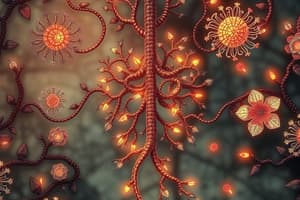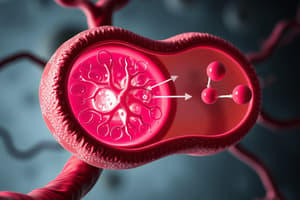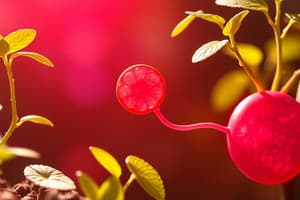Podcast
Questions and Answers
What molecule is the primary product of glycolysis that proceeds into the Krebs cycle, given the presence of oxygen?
What molecule is the primary product of glycolysis that proceeds into the Krebs cycle, given the presence of oxygen?
- Lactic acid
- Pyruvic acid (correct)
- Acetyl CoA
- Ethanol
Which type of cellular respiration requires the presence of oxygen?
Which type of cellular respiration requires the presence of oxygen?
- Lactic acid fermentation
- Anaerobic respiration
- Aerobic respiration (correct)
- Fermentation
What is the approximate net ATP production from cellular respiration using one molecule of glucose?
What is the approximate net ATP production from cellular respiration using one molecule of glucose?
- 18 ATP molecules
- 2 ATP molecules
- 36 ATP molecules (correct)
- 4 ATP molecules
Which molecule does pyruvate convert into in the mitochondria, after undergoing glycolysis?
Which molecule does pyruvate convert into in the mitochondria, after undergoing glycolysis?
What is the result of anaerobic respiration when there is insufficient oxygen available?
What is the result of anaerobic respiration when there is insufficient oxygen available?
What is the initial molecule that is broken down to start the process of glycolysis?
What is the initial molecule that is broken down to start the process of glycolysis?
What are the primary products generated through alcoholic fermentation?
What are the primary products generated through alcoholic fermentation?
What is the primary function of the thylakoid membranes in photosynthesis?
What is the primary function of the thylakoid membranes in photosynthesis?
What is the main reason for fermentation to occur during cellular respiration?
What is the main reason for fermentation to occur during cellular respiration?
Which molecules directly deliver high-energy electrons to the electron transport chain?
Which molecules directly deliver high-energy electrons to the electron transport chain?
Where does the electron transport chain occur within the cell?
Where does the electron transport chain occur within the cell?
What does ATP stand for, and what is its main function within cells?
What does ATP stand for, and what is its main function within cells?
What is the end product of pyruvate conversion during lactic acid fermentation?
What is the end product of pyruvate conversion during lactic acid fermentation?
Why is lactic acid fermentation classified as an anaerobic process?
Why is lactic acid fermentation classified as an anaerobic process?
What is the final electron acceptor in the electron transport chain during aerobic respiration?
What is the final electron acceptor in the electron transport chain during aerobic respiration?
In the context of photosynthesis, what is the ultimate product of the Calvin cycle?
In the context of photosynthesis, what is the ultimate product of the Calvin cycle?
What is the primary reason for oxygen debt accumulation in muscle cells?
What is the primary reason for oxygen debt accumulation in muscle cells?
What is the role of guard cells in a plant's leaves?
What is the role of guard cells in a plant's leaves?
Where does the Krebs cycle occur within a cell?
Where does the Krebs cycle occur within a cell?
Which of these processes directly uses the proton gradient to produce ATP?
Which of these processes directly uses the proton gradient to produce ATP?
What are the end products of cellular respiration?
What are the end products of cellular respiration?
What is the role of the electron transport chain in cellular respiration?
What is the role of the electron transport chain in cellular respiration?
Which statement about stomata is correct?
Which statement about stomata is correct?
How many main stages are involved in aerobic cellular respiration?
How many main stages are involved in aerobic cellular respiration?
What is the fluid-filled space inside the chloroplast called?
What is the fluid-filled space inside the chloroplast called?
In the process of cellular respiration, what molecule is represented by letter A in the diagram?
In the process of cellular respiration, what molecule is represented by letter A in the diagram?
Which of the following is the end product of alcoholic fermentation?
Which of the following is the end product of alcoholic fermentation?
In what organelle does the process of cellular respiration take place?
In what organelle does the process of cellular respiration take place?
What is the role of NAD+ in cellular respiration?
What is the role of NAD+ in cellular respiration?
Which of the following equations correctly represents cellular respiration?
Which of the following equations correctly represents cellular respiration?
Which process uses carbon dioxide and water to produce glucose and oxygen?
Which process uses carbon dioxide and water to produce glucose and oxygen?
What is the main energy currency that cells need for their survival?
What is the main energy currency that cells need for their survival?
What is the primary function of the proton gradient established during cellular respiration?
What is the primary function of the proton gradient established during cellular respiration?
Which of the following best describes the initial step in cellular respiration?
Which of the following best describes the initial step in cellular respiration?
What is the role of bromothymol blue in the context of photosynthesis?
What is the role of bromothymol blue in the context of photosynthesis?
Where do the light-dependent reactions of photosynthesis primarily occur?
Where do the light-dependent reactions of photosynthesis primarily occur?
Which of the following statements accurately reflects the main function of ATP synthase?
Which of the following statements accurately reflects the main function of ATP synthase?
What is the final electron acceptor in the electron transport chain of aerobic cellular respiration?
What is the final electron acceptor in the electron transport chain of aerobic cellular respiration?
What is produced by glycolysis, that is further used in the Krebs cycle if oxygen is available?
What is produced by glycolysis, that is further used in the Krebs cycle if oxygen is available?
What is the net gain of ATP molecules and pyruvate at the end of glycolysis?
What is the net gain of ATP molecules and pyruvate at the end of glycolysis?
What is the primary function of stomata during the day?
What is the primary function of stomata during the day?
According to the graph interpretation, which pigment absorbs light most effectively between 400-500 nm?
According to the graph interpretation, which pigment absorbs light most effectively between 400-500 nm?
Which chemical equation accurately represents the process of photosynthesis?
Which chemical equation accurately represents the process of photosynthesis?
In the chemical equation for photosynthesis, what are the reactants?
In the chemical equation for photosynthesis, what are the reactants?
What is produced by the process of photosynthesis?
What is produced by the process of photosynthesis?
Flashcards
Aerobic vs Anaerobic Respiration
Aerobic vs Anaerobic Respiration
Aerobic respiration requires the presence of oxygen to produce energy from glucose, while anaerobic respiration does not need oxygen and produces less energy.
Cellular Respiration
Cellular Respiration
Cellular respiration is the process by which cells break down glucose in the presence of oxygen to release energy in the form of ATP.
Glycolysis
Glycolysis
The first step of cellular respiration where glucose is broken down into pyruvate, generating a small amount of ATP.
Pyruvate to Acetyl-CoA
Pyruvate to Acetyl-CoA
Signup and view all the flashcards
Krebs Cycle
Krebs Cycle
Signup and view all the flashcards
Fermentation
Fermentation
Signup and view all the flashcards
Lactic Acid Fermentation
Lactic Acid Fermentation
Signup and view all the flashcards
Bromothymol Blue
Bromothymol Blue
Signup and view all the flashcards
Photosynthesis
Photosynthesis
Signup and view all the flashcards
Oxygen
Oxygen
Signup and view all the flashcards
Oxidative Phosphorylation
Oxidative Phosphorylation
Signup and view all the flashcards
Aerobic Respiration
Aerobic Respiration
Signup and view all the flashcards
Oxygen Debt
Oxygen Debt
Signup and view all the flashcards
Guard Cells
Guard Cells
Signup and view all the flashcards
Electron Transport Chain
Electron Transport Chain
Signup and view all the flashcards
Alcoholic Fermentation
Alcoholic Fermentation
Signup and view all the flashcards
ATP
ATP
Signup and view all the flashcards
Electron Carrier
Electron Carrier
Signup and view all the flashcards
Stroma
Stroma
Signup and view all the flashcards
Glucose
Glucose
Signup and view all the flashcards
Pyruvate
Pyruvate
Signup and view all the flashcards
ATP Synthase
ATP Synthase
Signup and view all the flashcards
6CO2 + 6H2O + light energy → C6H12O6 + 6O2
6CO2 + 6H2O + light energy → C6H12O6 + 6O2
Signup and view all the flashcards
Chlorophyll a
Chlorophyll a
Signup and view all the flashcards
Stomata
Stomata
Signup and view all the flashcards
Stomata opening and closing
Stomata opening and closing
Signup and view all the flashcards
Study Notes
Cellular Respiration
- Aerobic respiration requires oxygen, while anaerobic respiration does not.
- Plants need oxygen for cellular respiration.
- Organisms need oxygen to perform cellular respiration and produce ATP.
- Cellular respiration uses one molecule of glucose to produce approximately 36 ATP molecules.
- Cellular respiration is the process that breaks down food molecules to release energy.
- Pyruvate is converted to acetyl CoA in the mitochondria after glycolysis.
- The production of lactic acid is a result of anaerobic respiration.
- An insufficient amount of oxygen reaching the cells results in anaerobic respiration.
- Fermentation is a process that produces less ATP than aerobic respiration.
Photosynthesis
- Chlorophyll a absorbs light in the 400-500 nm range.
- The balanced chemical equation for photosynthesis is: 6CO2 + 6H2O + light energy → C6H12O6 + 6O2
- Photosynthesis uses carbon dioxide and water to produce glucose and oxygen.
- Cellular respiration uses glucose and oxygen to produce carbon dioxide and water.
Other
- The light-independent reactions of photosynthesis take place within the thylakoid membranes.
- The final electron acceptor in the electron transport chain is oxygen.
- The primary purpose of fermentation in cellular respiration is to regenerate NAD+ for glycolysis to continue.
- The electron transport chain occurs in the inner mitochondrial membrane.
- ATP stands for adenosine triphosphate and powers many cellular processes.
- Glycolysis is the first step in cellular respiration and it breaks down glucose into pyruvate.
- The products of cellular respiration are carbon dioxide, water, and ATP.
- Glycolysis is the only stage of cellular respiration that does not require oxygen.
- The two main types of fermentation are alcoholic and lactic acid fermentation.
- Guard cells control the opening and closing of stomata.
- The stroma is the fluid-filled space inside the chloroplast.
- The starting molecule for glycolysis is glucose.
- The main role of ATP synthase in cellular respiration is to produce ATP from ADP and inorganic phosphate.
- The statement "Guard cells control the opening and closing of stomata" is true.
- The Citric Acid Cycle is also known as the Krebs Cycle.
Studying That Suits You
Use AI to generate personalized quizzes and flashcards to suit your learning preferences.




